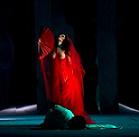Inspired by Hans Christian Andersen’s famous tale “The Little Mermaid” (1837), “Rusalka” by the Czech composer Anton Dvorak met with immediate success at its debut at the National Theatre in Prague on March 31, 1901. This is hardly surprising, given that this story of doomed love between two worlds, born of medieval legends, traversed the Renaissance before fueling the imagination of many 19th-century artists, choreographers, and musicians, all driven by the Romantic epic rediscovering the marvels of the fantastic. One can see examples like Karl Friedriech Hensler’s “Das Donauweibchen,” created in February 1798 in Vienna, “The Dniepr’s Rusalka” by Nikolai Krasnopolski and Stephan Davidov in 1805, “L’Ondine” by La Motte-Fouqué, performed at the Schauspielhaus in Berlin in 1816, followed by Pushkin’s “Rusalka” in 1819, another “Ondine” staged at the Magdeburg National Theatre in April 1845, and revisited in a Russian “Rusalka” by composer Dargomyjsky at the Theatre-Circus in Saint Petersburg in May 1856. Mendelssohn drew inspiration from it in his 1863 opera and Wagner in his “Rhine Daughters.” Rimsky-Korsakov brought his “Rusalka” to life in “May Night” at the Mariinsky Theatre in 1880, while Charles Gounod conjured “the waters of the Rhône, Trèves, and other dead maidens” in “Mireille” in 1864. Suffice it to say, interpretations of this work have been abundant.
Hence, there is a benevolent curiosity concerning the bold choice of a completely renovated staging and an original dramaturgy, which Marion Wasserman explains in a statement of intent: “viewing the story of ‘Rusalka’ through the eyes of the Prince, the main character, inspired by the life of Louis II of Bavaria, a king in love with dreams and the fantastic, connected to the moon and the night…the discomfort of a king and social man, his need for solitude, his sexual ambiguity and madness.” An interesting but risky gamble. And it could have been successful if this Laureate of the 2003 Ring Award International Stage Direction Competition in Freiburg for her project on “The Tales of Hoffmann” had, so to speak, fully realized her vision and entirely transposed the whole work into her dreamlike universe.
Instead, Marion Wasserman gives the impression of constantly hesitating between realism and symbolism, between classicism and modernity, between stage provocation and scrupulous respect for the script: at times, her staging suggests, while at others, it imposes heavily, leaving the spectator to drift between incomprehension and loss of dramatic bearings. Despite the division created by a dissociative decor—the palace and the beyond of the mirror—capable of stirring certain creativity, this dramaturgical ambivalence also had the unfortunate consequence of turning the stage into a no man’s land, disorienting artists constrained to tedious repetitions or theatrical mimicries.
Should the stage direction also be blamed for the poor vocal qualities of the lyrical artists? In any case, the two leading roles were unable to evoke—even understatement—the slightest enthusiasm: in her portrayal of “Rusalka,” soprano Nathalia Ushakova is practically inaudible from start to finish in the three acts, except when she shouts her high notes. Opposite her, Russian tenor Vsevolod Grivnov struggles: caught in a role of a depressive and repressed homosexual that he does not embrace, coupled with his falsely distressed face making him a formidable double of Régis Laspalès, his thin vocal line adds to his overall suffering—and ours! As often, it is the supporting roles that enhance the overall performance: Armenian bass Arutjun Kotchinian delivers stable and consistent lows, while mezzo-soprano Denisa Hamarova convincingly portrays the dual roles of the witch Jezibaba and the foreign princess. A special mention for the service’s muscular baritone-bass Adam Plachetka and the charming soubrette who holds her own, mezzo-soprano Juliette Mars. We should, to be fair, acknowledge the excellent lyrical and stage performance of the three nymphs who play, dance, and sing comfortably: Claudia Sorokina, Patricia Fernandez, and Christina Greco. The well-managed Chorus of the Opéra de Nice was not superfluous in saving the overall performance.
Fortunately, the musical beauty of the score is finely rendered by the Orchestre Philharmonique de Nice, placed harmoniously under the direction of Claude Schnitzler, a conductor with an unfaltering mischievous smile, despite so many disappointments.
Photos: Dominique Jaussein


